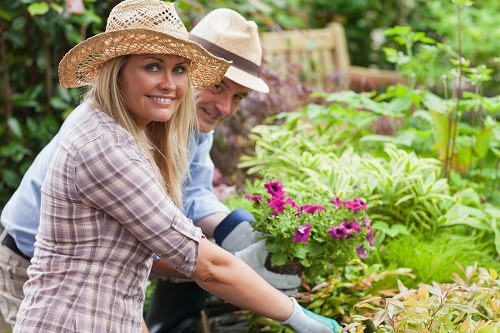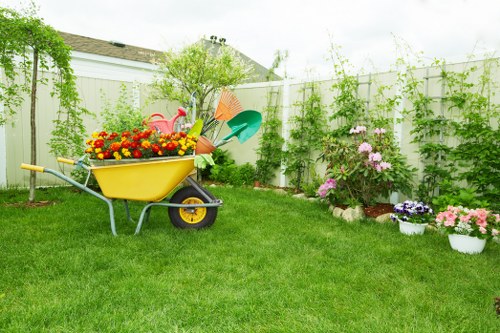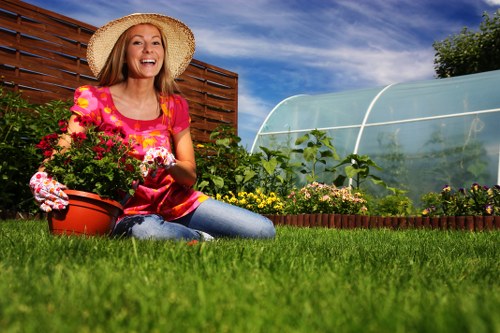Gardeners Wood Green: Cultivating Green Spaces in the Heart of London

Wood Green, located in the vibrant north of London, is a hub for gardening enthusiasts and professionals alike. The area boasts a rich history of green spaces, community gardens, and a supportive network for both novice and experienced gardeners. Whether you're looking to start your own garden or enhance an existing one, Gardeners Wood Green offers a plethora of resources and opportunities.
One of the key attractions in Wood Green is its accessibility to various gardening centers and nurseries. These establishments provide a wide range of plants, tools, and expert advice, making it easier for residents to cultivate their green spaces. From seasonal flowers to hardy perennials, the options are abundant for those looking to add color and life to their gardens.
Community gardens play a significant role in Wood Green, fostering a sense of camaraderie among gardeners. These shared spaces not only allow individuals to grow their own produce but also serve as a venue for workshops, plant exchanges, and social gatherings. Engaging in community gardening activities can enhance your gardening skills and expand your network within the local gardening community.

Essential Gardening Resources in Wood Green
Wood Green offers a variety of resources tailored to the needs of gardeners. Whether you're a beginner or a seasoned gardener, you'll find valuable tools and information to support your gardening journey.
Local Nurseries and Plant Shops: These stores provide a wide selection of plants suited to the local climate. Many nurseries also offer gardening supplies such as soil, fertilizers, and gardening tools.
Workshops and Classes: Learning from experienced gardeners can greatly enhance your gardening skills. Wood Green hosts regular workshops covering topics like organic gardening, pest management, and landscape design.

Gardening Associations and Clubs
Joining a gardening association or club in Wood Green can provide numerous benefits. These organizations often organize events, provide access to exclusive gardening resources, and offer a platform to share knowledge and experiences with fellow gardeners.
- Wood Green Gardening Society: A local group that meets monthly to discuss gardening trends, share tips, and organize community projects.
- Urban Gardening Club: Focuses on gardening in small spaces, perfect for residents with limited outdoor areas.
- Organic Gardeners Network: Dedicated to promoting sustainable and eco-friendly gardening practices.
Participating in these groups can inspire new ideas and provide support as you navigate the challenges of gardening.

Best Practices for Urban Gardening in Wood Green
Urban gardening presents unique challenges, but with the right techniques, you can create a thriving garden even in limited spaces. Here are some best practices to consider:
- Container Gardening: Utilize pots, balconies, and window boxes to grow plants. This method is ideal for those with limited ground space.
- Vertical Gardening: Maximize space by growing plants vertically using trellises, hanging pots, and vertical planters.
- Soil Health: Invest in quality soil and regularly amend it with compost to ensure your plants receive adequate nutrients.
- Water Management: Implement efficient watering systems like drip irrigation to conserve water and ensure consistent moisture for your plants.
- Sunlight Optimization: Position your plants to receive the appropriate amount of sunlight, and consider shade cloths or reflective materials to manage excessive heat.
Adhering to these practices can help you create a sustainable and productive urban garden.

Seasonal Gardening Tips for Wood Green
Gardening in Wood Green requires adapting to the seasonal changes to maintain a healthy and vibrant garden throughout the year. Here are some tips for each season:
Spring
Spring is the perfect time to plant new flowers and vegetables. Start by preparing your garden beds and adding compost to enrich the soil. Plant hardy annuals and perennials that thrive in cooler temperatures.
Summer
During the summer months, focus on maintaining your garden by regularly watering and pruning plants. Introduce heat-tolerant varieties and provide ample shade to protect sensitive plants from the scorching sun.
Autumn
Autumn is ideal for planting bulbs that will bloom in the spring. Clear out spent plants and add mulch to protect the soil from winter freezes. This season is also great for preparing your garden for the colder months.
Winter
In winter, focus on garden maintenance by protecting plants with covers and ensuring that tools are properly stored. Plan your garden layout for the upcoming year and order seeds to get a head start in spring.
Wood Green's climate, characterized by mild winters and warm summers, is conducive to a wide range of gardening activities. By understanding and utilizing the local climate, gardeners can ensure the health and productivity of their gardens year-round.
One of the significant advantages of gardening in Wood Green is the community support available. Local gardening groups and online forums offer platforms to ask questions, share successes, and seek advice from knowledgeable individuals.
Accessibility to public gardens and parks in Wood Green also provides inspiration and opportunities to learn from established gardens. Visiting these spaces can offer new ideas for your own garden design and plant selection.
Top Gardening Spots in Wood Green
Exploring the top gardening spots in Wood Green can provide both inspiration and practical locations to practice your gardening skills.
Wood Green Market Gardens: A collection of community gardens where residents can rent plots to grow their own plants and vegetables.
Croydon Park Gardens: A large public park featuring diverse plant species, perfect for leisurely strolls and gardening inspiration.
Harringay Park: Known for its ornamental gardens and extensive green spaces, offering a peaceful environment for gardening enthusiasts.
Innovative Gardening Techniques in Wood Green
Gardeners in Wood Green are increasingly adopting innovative techniques to maximize their gardening potential. These methods not only enhance plant growth but also contribute to sustainable gardening practices.
- Hydroponics: Growing plants without soil, using nutrient-rich water solutions. This technique is ideal for indoor gardening and areas with poor soil quality.
- Composting: Recycling kitchen and garden waste into nutrient-rich compost to improve soil fertility.
- Rainwater Harvesting: Collecting and storing rainwater for use in watering plants, promoting water conservation.
- Permaculture: Designing gardens that mimic natural ecosystems, emphasizing sustainability and biodiversity.
Incorporating these techniques can lead to more efficient and eco-friendly gardening practices.
Gardening Events and Workshops in Wood Green
Participating in local gardening events and workshops can significantly enhance your gardening knowledge and skills. Wood Green hosts a variety of events throughout the year, catering to different aspects of gardening.
Spring Planting Festival: An annual event celebrating the start of the gardening season with plant sales, workshops, and demonstrations.
Urban Gardening Seminars: Regular seminars focusing on urban gardening challenges and solutions, including space optimization and sustainable practices.
Community Garden Days: Events where gardeners come together to work on community projects, share knowledge, and celebrate their collective efforts.
Local Gardening Experts in Wood Green
Access to local gardening experts can be invaluable for personalized advice and troubleshooting. Wood Green is home to several knowledgeable gardeners and horticulturists who offer consultations and services.
- John Smith - Horticulturist: Specializes in organic gardening and sustainable practices. Offers one-on-one consultations and workshops.
- Mary Johnson - Landscape Designer: Provides design services for both residential and community gardens, focusing on aesthetic and functional layouts.
- David Lee - Community Garden Coordinator: Manages local community gardens and organizes events to promote gardening education and participation.
Leveraging the expertise of these professionals can help you overcome gardening challenges and achieve your gardening goals.
10-15 Closest Areas to Wood Green for Gardeners
Wood Green is surrounded by several areas that offer unique features and resources for gardeners. Here's a look at the nearby areas that are worth exploring:
- Seven Sisters: Just a short distance from Wood Green, Seven Sisters features vibrant community gardens and local nurseries.
- Turnpike Lane: Known for its extensive selection of gardening supplies and seasonal plant sales.
- Finsbury Park: Home to large public gardens and parks, ideal for those seeking inspiration and open space.
- Tottenham: Offers community gardening initiatives and educational workshops on urban gardening.
- Hornsey: Features eco-friendly gardening options and sustainable plant varieties.
- Bounds Green: Known for its ornamental gardens and local plant enthusiasts.
- Stroud Green: Offers specialized gardening stores and botanical centers.
- Alexandra Palace: Hosts botanical exhibitions and gardening events throughout the year.
- Southgate: Provides access to community-supported agriculture programs and local farming resources.
- Muswell Hill: Features heritage gardens and historic plant collections.
- Arnos Grove: Known for its diverse plant species and gardening societies.
- Highgate: Offers premium gardening services and exclusive plant varieties.
- Croydon Although slightly further, Croydon offers extensive gardening centers and large public parks.
- Palmers Green: Features community-driven gardening projects and accessible green spaces.
- East Finchley: Known for its urban gardening initiatives and sustainable planting programs.
- Chalk Farm: Offers unique gardening workshops and experimental plantings.
Choosing the Right Plants for Wood Green's Climate
Selecting plants that thrive in Wood Green's climate is crucial for a successful garden. The area's temperate climate with mild winters and warm summers allows for a diverse range of plant species.
- Perennials: Plants like lavender, echinacea, and hostas that return year after year.
- Annuals: Bright and colorful plants such as marigolds, petunias, and zinnias that bloom throughout the summer.
- Vegetables: Hardy vegetables like tomatoes, peppers, and leafy greens that grow well in the local conditions.
- Herbs: Aromatic herbs like basil, rosemary, and thyme that thrive in both containers and garden beds.
- Shade-Tolerant Plants: Ferns, impatiens, and begonias suitable for areas with limited sunlight.
By choosing the right plants, you can ensure a vibrant and resilient garden that stands the test of time.
Maintaining Your Garden in Wood Green
Regular maintenance is essential to keep your garden healthy and aesthetically pleasing. Here are some maintenance tips specific to Wood Green:
- Pruning: Regularly trim your plants to encourage healthy growth and remove any dead or diseased parts.
- Weed Control: Keep your garden beds free from weeds that compete with your plants for nutrients and water.
- Pest Management: Monitor your plants for signs of pests and use eco-friendly methods to control infestations.
- Soil Testing: Periodically test your soil to ensure it has the right pH and nutrient levels for your plants.
- Mulching: Apply mulch to retain soil moisture, suppress weeds, and regulate soil temperature.
Implementing these maintenance practices can lead to a thriving and beautiful garden.
Eco-Friendly Gardening Practices
Adopting eco-friendly gardening practices not only benefits your garden but also the environment. Here are some sustainable methods to consider:
- Composting: Recycle kitchen and garden waste into compost to enrich your soil naturally.
- Rainwater Harvesting: Collect and use rainwater for your plants, reducing reliance on tap water.
- Natural Pest Control: Use beneficial insects or organic pesticides to manage pests without harming the ecosystem.
- Native Plants: Plant native species that are adapted to the local climate and require less maintenance.
- Energy-Efficient Tools: Use manual or battery-powered gardening tools to minimize energy consumption.
Incorporating these practices can lead to a more sustainable and resilient garden.
Benefits of Gardening in Wood Green
Gardening offers numerous benefits, both personal and community-wide, especially in an area like Wood Green.
- Physical Health: Gardening is a great form of exercise, improving strength, flexibility, and overall fitness.
- Mental Well-being: Spending time in the garden can reduce stress, boost mood, and enhance mental clarity.
- Community Engagement: Community gardens foster social connections and a sense of belonging among residents.
- Environmental Impact: Gardens contribute to urban green spaces, improve air quality, and support biodiversity.
- Economic Savings: Growing your own vegetables and herbs can reduce grocery bills and promote self-sufficiency.
These benefits make gardening a valuable and rewarding activity for individuals and the community as a whole.
Gardening Challenges in Wood Green
While gardening in Wood Green is highly rewarding, it comes with its set of challenges. Understanding these obstacles can help you prepare and overcome them effectively.
- Limited Space: Urban environments often mean limited space for gardening. Utilizing vertical and container gardening can help maximize available areas.
- Pollution: Urban pollution can affect soil quality and plant health. Regular soil testing and using raised beds can mitigate these effects.
- Weather Extremes: Unexpected weather changes can impact plant growth. Implementing protective measures like shade cloths and windbreaks can provide stability for your garden.
- Pest Infestations: Urban gardens are susceptible to various pests. Integrated pest management strategies can help control infestations without harming beneficial insects.
- Resource Availability: Access to quality gardening resources can be limited. Connecting with local gardening groups and nurseries can enhance resource availability.
Addressing these challenges proactively can lead to a successful and thriving garden.
Future of Gardening in Wood Green
The future of gardening in Wood Green looks promising, with increasing interest in sustainable and community-focused gardening practices. Innovations in urban gardening techniques and a growing emphasis on environmental sustainability are set to shape the gardening landscape.
Advancements in technology, such as smart gardening tools and automated irrigation systems, are making gardening more efficient and accessible. Additionally, the rise of community-supported agriculture (CSA) programs is fostering stronger connections between gardeners and the local community.
As more residents embrace gardening, Wood Green is likely to see an expansion of green spaces, improved community health, and a stronger sense of community. The ongoing support from local organizations and the enthusiasm of gardeners will continue to drive the growth of gardening in the area.
Conclusion
Gardeners Wood Green is more than just a location; it's a thriving community where passion for gardening meets the beauty of urban green spaces. With abundant resources, a supportive network, and a commitment to sustainable practices, Wood Green offers an ideal environment for gardeners to flourish.
Whether you're just starting your gardening journey or looking to expand your existing skills, Wood Green provides the tools, knowledge, and community support to help you succeed. Embrace the opportunities available and contribute to the vibrant gardening culture that makes Wood Green a standout destination for gardeners.
Frequently Asked Questions
1. What are the best times of year to start a garden in Wood Green?
The best times to start a garden in Wood Green are during the spring and autumn months. Spring offers ideal conditions for planting a variety of flowers and vegetables, while autumn is perfect for planting bulbs and preparing your garden for the winter months.
2. Are there any community gardening programs available in Wood Green?
Yes, Wood Green has several community gardening programs that offer shared garden plots, workshops, and events. Organizations like the Wood Green Gardening Society and the Urban Gardening Club provide opportunities for residents to engage in community gardening activities.
3. How can I manage pests organically in my Wood Green garden?
Managing pests organically can be achieved by introducing beneficial insects, using natural pesticides, and practicing crop rotation. Additionally, maintaining healthy soil and plant diversity can help prevent pest infestations.
4. Where can I find gardening supplies in Wood Green?
Wood Green is home to numerous nurseries and plant shops where you can find a wide range of gardening supplies. Popular locations include local nurseries on Turnpike Lane and specialized gardening stores in nearby areas like Seven Sisters and Hornsey.
5. What are some space-saving gardening techniques for small gardens in Wood Green?
Space-saving techniques include container gardening, vertical gardening, and utilizing hanging pots. These methods allow you to maximize limited space and still enjoy a productive and vibrant garden.


